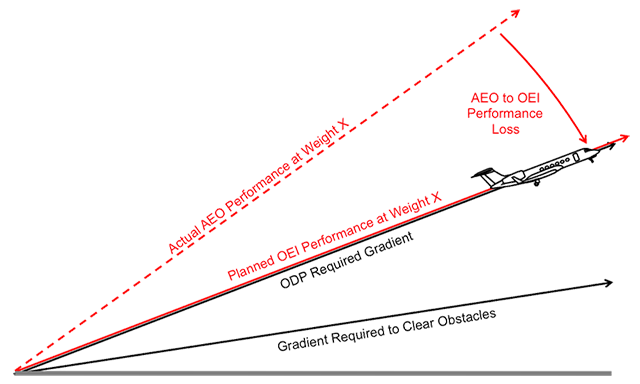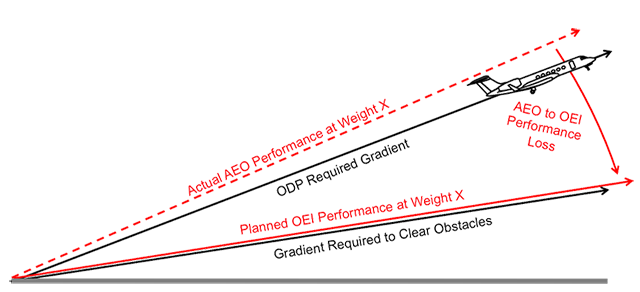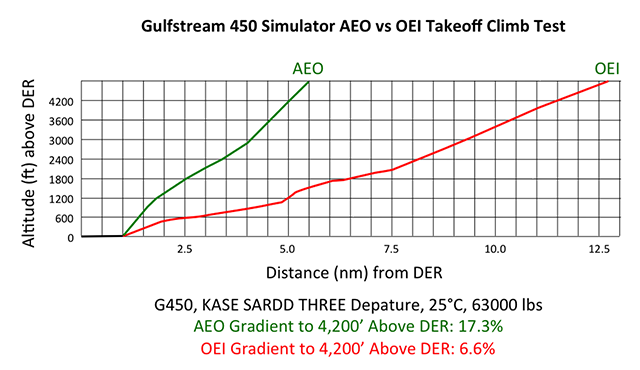If you reduce your One Engine Inoperative (OEI) vertical performance climb as a way of increasing payload while still meeting obstacle clearance requirements, you will still need to meet All Engines Operative (AEO) obstacle departure procedure climb gradients. Very few Airplane Flight Manuals (AFMs) provide AEO takeoff climb performance because there is no regulatory requirement to do so. If that is the case for you, how do ensure you can meet the ODP climb gradient?
— James Albright

Updated:
2015-03-18
The FAA isn't much help here; they say only that you must consider it. What follows is simply a theory that I think makes perfect sense. I've tested this in CL-604, GIV, GV, and G450 simulators. I am including my G450 test results here. I cannot provide you an answer other than to say these are my results and I encourage you to check them in your simulator.
2 — Deriving minimum AEO takeoff climb performance from OEI performance

1
Why this matters
The "old school" strategy for dealing with obstacle departure climb gradients is to use the AFM's OEI performance data to beat the AEO minimum climb gradient:
The Pitkin County / Sardy Airport in Aspen, Colorado (KASE) obstacle departure procedure requires the weather be at least 400-1 with a minimum climb gradient of 460 feet per nautical mile to 14,000 feet. If an AFM doesn't have AEO performance data, a typical response would be to plan to meet or exceed the requirement using OEI data. That way, even if you lose an engine, you will make the requirement.
There are several strategies to increase departure payload, fuel and/or passengers, while still meeting obstacle clearance requirements. Most of these strategies involve reducing the vertical margin above obstacles, reasoning that if an engine is lost, the aircraft no longer has to meet AEO climb gradients. That is certainly true. More about that: Departure Obstacle Avoidance - A Strategy.
The problem with these strategies is that if the AFM does not have AEO takeoff performance data, how does one ensure ODP climb gradients will be met if no engines are lost?
In the Aspen example, the published AEO climb gradient is 7.6 percent and the required obstacle clearance is 24 percent. If the aircraft is loaded to provide for only (7.6) (1 - 0.24) = 5.8 percent, obstacle clearance is still assured even if an engine is lost. But if the aircraft doesn't lose an engine it still needs to meet the 7.6 percent gradient. Will it?
2
Deriving minimum AEO takeoff climb performance from OEI performance
You can come up with a conservative estimate of All Engine Operating (AEO) takeoff climb performance by multiplying the Airplane Flight Manual One Engine Inoperative (OEI) performance by the factor indicative of the power loss. If you are flying a two-engine aircraft, for example, you are getting half your climb gradient from each engine. If you lose an engine, your climb gradient decreases by at least 50 percent because you will also have the parasite drag from the wind milling or seized engine. Therefore:
- A two engine aircraft operating with AEO will at least double its OEI climb gradient.
- A three-engine aircraft operating with AEO will outperform its OEI climb gradient by at least 33 percent.
- A four-engine aircraft operating with AEO will outperform its OEI climb gradient by at least 25 percent.
This theory is based simply on the fact the AEO number represents 100% of the thrust and the OEI is derived from the proportional loss of thrust (one-half, one-third, or one-fourth) with an additional penalty of the failed engine's parasite drag. But does the theory hold up in actual practice? This can be checked easily enough if your AFM provides both AEO and OEI data, or with an accurate flight simulator.
3
G450 simulator test
I've tested this several times, most recently in a G450 simulator. We loaded the airplane up to the gradient required to clear all obstacles, froze the fuel and flew two takeoffs. The first was with an engine failed at V1 and the second with everything cooking. Our AEO performance was 2.6 times greater than the OEI performance. This validates our theory that the AEO climb gradient will be at least double the OEI gradient.
If you are flying a three-engine or four-engine aircraft, in fact if you are flying any multi-engine aircraft other than a G450, I would be very happy to post your results. Just ask the simulator operator to give you an altitude / distance plot and make sure the conditions are equal for both an AEO and a OEI run. "Contact Us" below.


